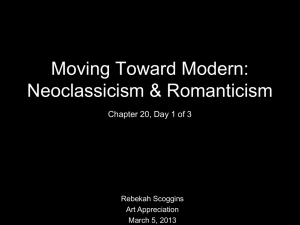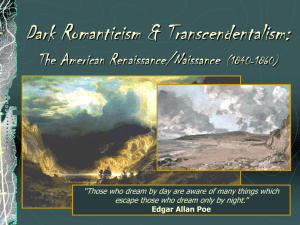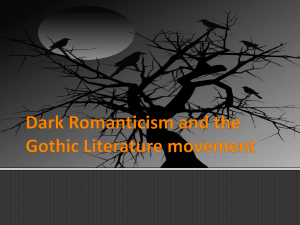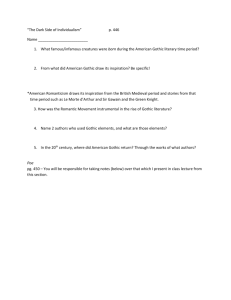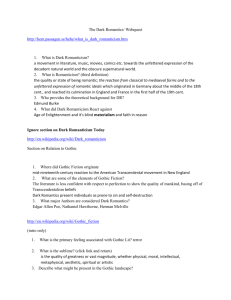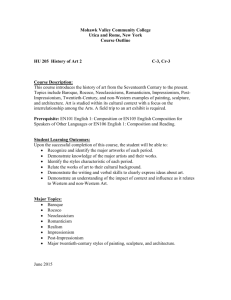Lara Bezich Essay Test: Neoclassicism and Romanticism Prof
advertisement
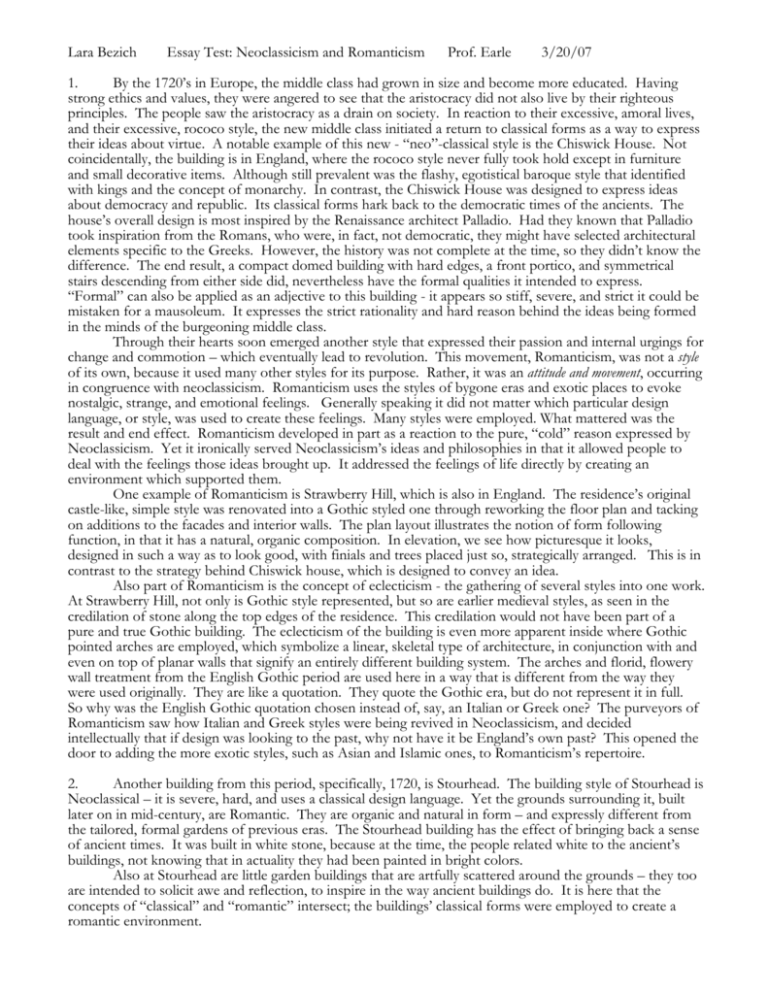
Lara Bezich Essay Test: Neoclassicism and Romanticism Prof. Earle 3/20/07 1. By the 1720’s in Europe, the middle class had grown in size and become more educated. Having strong ethics and values, they were angered to see that the aristocracy did not also live by their righteous principles. The people saw the aristocracy as a drain on society. In reaction to their excessive, amoral lives, and their excessive, rococo style, the new middle class initiated a return to classical forms as a way to express their ideas about virtue. A notable example of this new - “neo”-classical style is the Chiswick House. Not coincidentally, the building is in England, where the rococo style never fully took hold except in furniture and small decorative items. Although still prevalent was the flashy, egotistical baroque style that identified with kings and the concept of monarchy. In contrast, the Chiswick House was designed to express ideas about democracy and republic. Its classical forms hark back to the democratic times of the ancients. The house’s overall design is most inspired by the Renaissance architect Palladio. Had they known that Palladio took inspiration from the Romans, who were, in fact, not democratic, they might have selected architectural elements specific to the Greeks. However, the history was not complete at the time, so they didn’t know the difference. The end result, a compact domed building with hard edges, a front portico, and symmetrical stairs descending from either side did, nevertheless have the formal qualities it intended to express. “Formal” can also be applied as an adjective to this building - it appears so stiff, severe, and strict it could be mistaken for a mausoleum. It expresses the strict rationality and hard reason behind the ideas being formed in the minds of the burgeoning middle class. Through their hearts soon emerged another style that expressed their passion and internal urgings for change and commotion – which eventually lead to revolution. This movement, Romanticism, was not a style of its own, because it used many other styles for its purpose. Rather, it was an attitude and movement, occurring in congruence with neoclassicism. Romanticism uses the styles of bygone eras and exotic places to evoke nostalgic, strange, and emotional feelings. Generally speaking it did not matter which particular design language, or style, was used to create these feelings. Many styles were employed. What mattered was the result and end effect. Romanticism developed in part as a reaction to the pure, “cold” reason expressed by Neoclassicism. Yet it ironically served Neoclassicism’s ideas and philosophies in that it allowed people to deal with the feelings those ideas brought up. It addressed the feelings of life directly by creating an environment which supported them. One example of Romanticism is Strawberry Hill, which is also in England. The residence’s original castle-like, simple style was renovated into a Gothic styled one through reworking the floor plan and tacking on additions to the facades and interior walls. The plan layout illustrates the notion of form following function, in that it has a natural, organic composition. In elevation, we see how picturesque it looks, designed in such a way as to look good, with finials and trees placed just so, strategically arranged. This is in contrast to the strategy behind Chiswick house, which is designed to convey an idea. Also part of Romanticism is the concept of eclecticism - the gathering of several styles into one work. At Strawberry Hill, not only is Gothic style represented, but so are earlier medieval styles, as seen in the credilation of stone along the top edges of the residence. This credilation would not have been part of a pure and true Gothic building. The eclecticism of the building is even more apparent inside where Gothic pointed arches are employed, which symbolize a linear, skeletal type of architecture, in conjunction with and even on top of planar walls that signify an entirely different building system. The arches and florid, flowery wall treatment from the English Gothic period are used here in a way that is different from the way they were used originally. They are like a quotation. They quote the Gothic era, but do not represent it in full. So why was the English Gothic quotation chosen instead of, say, an Italian or Greek one? The purveyors of Romanticism saw how Italian and Greek styles were being revived in Neoclassicism, and decided intellectually that if design was looking to the past, why not have it be England’s own past? This opened the door to adding the more exotic styles, such as Asian and Islamic ones, to Romanticism’s repertoire. 2. Another building from this period, specifically, 1720, is Stourhead. The building style of Stourhead is Neoclassical – it is severe, hard, and uses a classical design language. Yet the grounds surrounding it, built later on in mid-century, are Romantic. They are organic and natural in form – and expressly different from the tailored, formal gardens of previous eras. The Stourhead building has the effect of bringing back a sense of ancient times. It was built in white stone, because at the time, the people related white to the ancient’s buildings, not knowing that in actuality they had been painted in bright colors. Also at Stourhead are little garden buildings that are artfully scattered around the grounds – they too are intended to solicit awe and reflection, to inspire in the way ancient buildings do. It is here that the concepts of “classical” and “romantic” intersect; the buildings’ classical forms were employed to create a romantic environment. The Memorial to Newton, designed by a radical French architect of the 18th century, also encompasses both classical and romantic concepts. It is classical in that it is comprised of geometric forms, it is basically a huge sphere perched on a cylindrical base. Yet because it is so extreme in its scale, and extreme in its simplicity, it cannot be considered truly classical, since classicism is about balance. The memorial has such a dramatic effect, (or would have, due to its size it was never built) that it produces emotions, thus pushing it into the realm of Romanticism. 3. In England, Neoclassicism developed from its hard, bold origins as exemplified by the Chiswick House into a more delicate, complicated and even eclectic style, perhaps by influence from the Romantic movement. The Kenwood Library is an example of this later Neoclassicism. It was designed by Robert Adam, a master at combining disparate details into a pleasing whole. The general form and architecture of the space is informed from Roman basilica spaces, having a long, rectangular shape with barrel vault ceiling, sectioned off in a geometrical grid. At the end of the large room is an apse with walls full of books. Slender Corinthian columns separate this space from the rest of the room. Along the edges of ceiling and walls are the usual classical moldings. Adams studied ancient buildings intently to get the parts just right. In addition to all this order, there is delight for the eye, in the delicate decorative details that fill the spaces in between in a just-right way. They are arranged symmetrically and artfully, and the motifs are copied also from ancient Roman buildings. One particular Roman motif that is used extensively in neoclassical style is the “smile” ornament, comprised of some variation of ribbon, garland, or beads, draped in a way that looks like a smile. The furniture also employs classical forms, the curvy chair leg of the Rococo is replaced with a cubic form at the joint like the ones seen in ancient architecture. The legs and frames are treated like architectural parts, and articulated as columns or beams with an emphasis at the intersections, celebrating the distinction of parts. The overall effect and intention of all this is to create a particular mood, or support a particular function, in this case, study and reading, using the language of classicism. For other functions and rooms, the language was tweaked to suite their purposes. In France, the development of neoclassicism and romanticism was more gradual than in England where it coincided with revolution. In France it was more of an evolution – the aristocrats chose to implement neoclassicism and romanticism because it was fashionable and seemed appropriate since they had a new king, to go ahead and pick a new style. Since Rococo was so loved, their neoclassicism took the elements of rococo and crisped them up a bit, and arranged them symmetrically instead of organically. They added borders and distinctions. This was in the 1750’s. In 1789, the French Revolution began, and its leader, Napolean, enacted a new style in his home that became and remains even today somewhat popular – The Empire Style. His wife Josephine’s bedroom is an excellent example of this style. It can be considered a “Romantic Classicism,” in that is uses classical elements for romantic purposes. The term “empire” recalls notions of the baroque style, and indeed this bedroom also shares qualities with the baroque. It has a theatrical feel, and aggressive, big decorative details like full-size swans on the bed frame. Intense, heavy colors such as yellow, red, and gold further dramatize the space. The room itself is circular, ringed in columns and with a heavy cornice and molding. Between the columns hang drapes of fabric, which serve to visually activate the space even more. The ceiling is pitched up like the roof of a tent, and decorated with frilly motifs. Indeed the room feels like some exotic tent, spurring the imagination, recalling nostalgic dreams about past lives. Josephine compared herself to Cleopatra of Egypt, and this bedroom certainly adds fuel to that fire of imagination. The furniture, too, recalls ancient cultures, borrowing from the Greek klismos chair, reinventing the curved legs into what are now called saber legs and characterize the empire style in furniture, as do the use of large scale decorative ornament. The furniture is weighty and masculine, unlike the thin, light furniture of the neoclassical style. In this way it is more dramatic.
